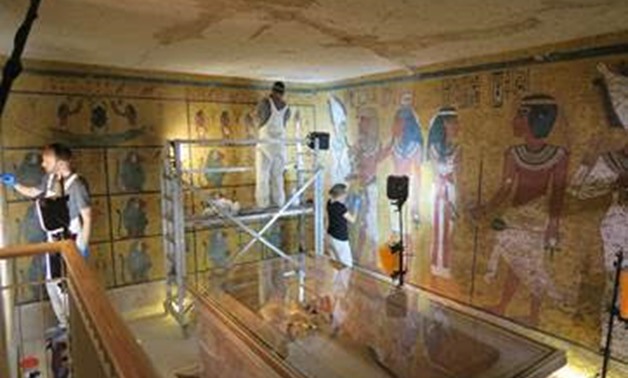
Conservation work on the wall paintings in the tomb © J. Paul Getty Trust,-Photo courtesy of statement by GCI.
CAIRO – 28 March 2018: The Getty Conservation Institute (GCI), based in Los Angeles, is almost done with its work at the Tomb of Tutankhamen in Egypt. It is well-known that this site is considered to be one of the most illustrious cultural heritage sites. GCI is internationally known for its conservation activities targeting diverse objects, collections, architecture, and sites.
Appreciating how significant the Tomb of Tutankhamen is, GCI collaborates with the Ministry of Antiquities to work on a project that aims to continually maintain the tomb.
The development and maintenance of this site included the conservation of wall paintings, environmental and infrastructure improvements, and providing a future care program for the site.
Tim Whalen, John E. and Louise Bryson, director of the Getty Conservation Institute, pointed out that the methodology used in this project can serve as a model to be followed at other similar sites.
The work at Tutankhamen’s tomb is a great testament that there is a community of experts and institutions who are willing to work together for the constant protection of cultural heritage everywhere.
Tutankhamen’s tomb, which is located in Egypt’s Valley of the Kings, was discovered in 1922. This discovery is considered one of the most extravagant discoveries in archeological history.
As British archaeologist and Egyptologist Howard Carter documented the tomb’s contents, some of them were exhibited in different regions all over the world. The main reason behind this collaboration was that the tomb was a mind-blowing discovery for people all over the world. Due to this discovery, numerous tourists insisted on witnessing this discovery by visiting Egypt.
 Tutankhamen pictured on the north wall of the burial chamber © J. Paul Getty Trust,-Photo courtesy of statement by GCI.
Tutankhamen pictured on the north wall of the burial chamber © J. Paul Getty Trust,-Photo courtesy of statement by GCI.
As for the tomb’s contents, it houses an assortment of objects, including the mummy of Tutankhamen, the quartzite sarcophagus with its granite lid on the floor beside it, the gilded wooden outermost coffin, and the wall paintings of the burial chamber, according to a statement by GCI.
According to Neville Agnew, GCI senior principal project specialist, the major problem that had been facing the tomb for years is humidity, which encourages microbiological growth, stressing wall paintings, while carbon dioxide creates an uncomfortable atmosphere for visitors.
The team includes many experts responsible for specific missions, including Egyptologists to conduct background research, environmental engineers to investigate the tomb’s microclimatic conditions, microbiologists to study mysterious brown spots on the surface of wall paintings, documentation specialists, and architects, amongst others.
Newly designed barriers have been built as part of the project to restrict visitor access in specific areas, as Tutankhamen’s tomb has seen various losses caused by visitors. A monitoring program has been established by GCI to improve the future the evaluation methods.
As for the upcoming collaborations, it was stated that a conference will be held in January 2019 to discuss the conservation and management of sites in Luxor.
This is not the first archeological achievement by GCI in Egypt, as it had previously worked on the Tomb of Queen Nefertari in the Valley of the Queens (1986–92), followed by the maintenance of the Valley of the Queens based on a solid conservation plan.


Comments
Leave a Comment